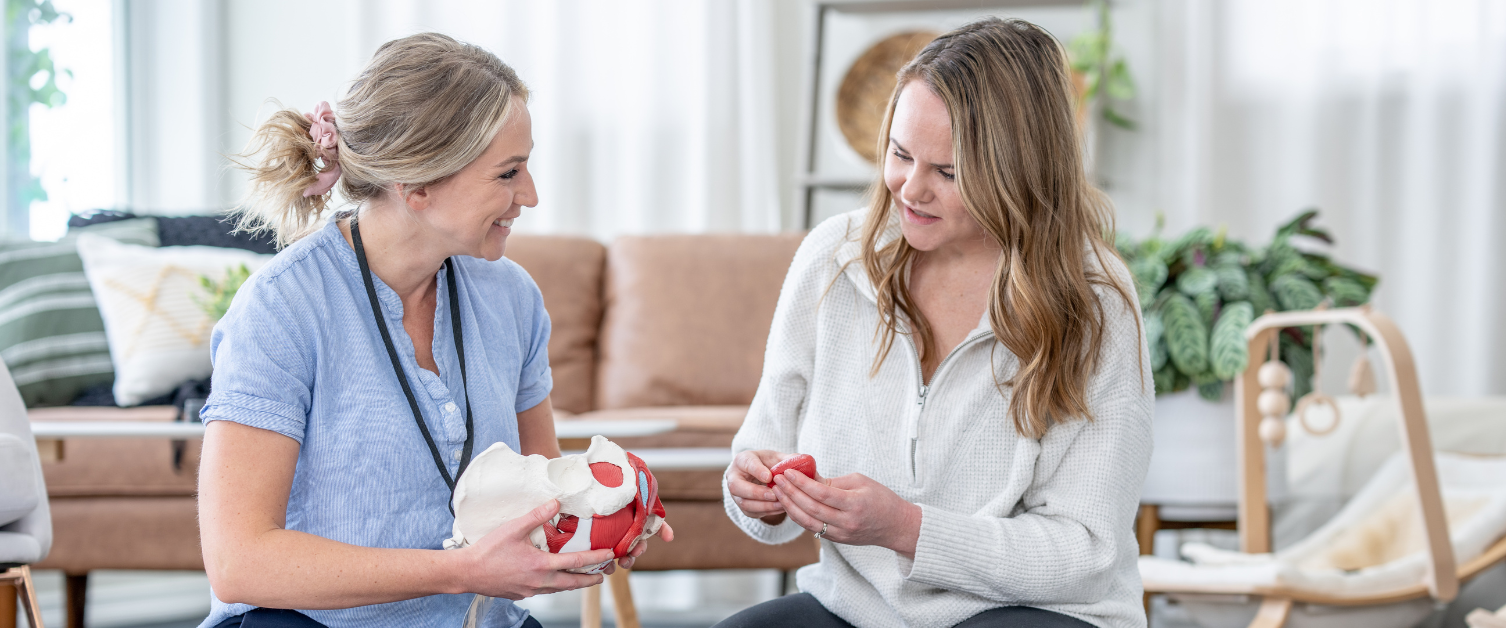Pelvic floor exercises

Pelvic floor exercises are usually mentioned during pregnancy and after you have had a baby. Pelvic floor exercises strengthen the muscles around your bladder, bottom, and vagina or penis.
Everyone can benefit from doing pelvic floor exercises.
Where is my pelvic floor?
Your pelvic floor is a set of muscles that sit inside your pelvis like a sling or hammock. They stretch from front to back (from the pubic bone at the front to the tail bone at the back) and side to side between the two sides of the pelvis (hip bones).
Watch this useful video from the NHS to help you find your pelvic floor muscles.
Why are the pelvic floor muscles so important?
The muscles of the pelvic floor help by:
- Supporting your pelvic organs (bladder, bowel, rectum, womb and vagina).
- Controlling our bladder and bowel. Whilst sitting on the toilet, the pelvic floor muscles have to relax and open to let us empty our bladder and bowels.
- They also tighten to stop us leaking urine, stool or wind when we don’t want to. For example when we cough, sneeze, run jump or are desperate to go to the toilet.
The pelvic floor, pregnancy and childbirth
When you are pregnant, the muscles in your body have to work harder than normal because they are carrying the weight of you and your growing baby. This includes your pelvic floor muscles.
The pelvic floor muscles can become stretched and weak during pregnancy. The pelvic floor muscles also have to stretch a lot during childbirth to help you give birth to your baby.
This is why so many women find that during pregnancy and after childbirth, it is difficult to hold in urine, wind and stool as easily as they could before.
It is really important to strengthen the pelvic floor muscles during pregnancy and after childbirth so that you are less likely to leak. Keeping your pelvic muscles strong also is important for supporting your pelvic organs (bladder, womb and bowels).
How do I do my pelvic floor exercises?
Start by sitting down on a firm surface like a kitchen chair, the toilet with the seat down or arm of the sofa. This way you can feel your pelvic floor muscles work more. If you don’t have a firm surface then sit on your hands.
To start your pelvic floor muscles working imagine that you are squeezing to stop yourself passing wind and wee at the same time. To do this you need to squeeze the muscles around your anus (where your poo comes out of). Then squeeze at the front as if you are stopping a wee. Squeeze them gradually until you are squeezing them as much as you can.
Check that you are not holding your breath and that your tummy and bottom cheeks are relaxed. Now stop squeezing and let the muscles relax.
Do not practice stopping a wee when you go to the toilet as this can cause bladder infections and other problems.
Once you get stronger at squeezing your pelvic floor muscles in sitting, you can make your exercises harder by doing them standing up.
How many pelvic floor exercises do I need to do and how often do I need to do them?
You should do pelvic floor exercises every day, and if possible 3 times a day.
You will need to do long pelvic floor squeezes and short squeezes.
Long squeezes are when you squeeze your pelvic floor muscles as much as you can (hold in wind and wee) and hold this full squeeze for up to 10 seconds. Relax the muscles and rest for a few seconds before you squeeze again. Aim to do 10 long squeezes, with a 4 second rest between each squeeze.
Short squeezes involve squeezing the pelvic floor muscles as hard and as fast as you can and relaxing them quickly. You do not hold the squeeze on this one. Aim to do 10 fast squeezes.
Further information on how to do your pelvic floor exercises for women can be found on the Pelvic, Obstetric and Gynaecological Physiotherapy website.
Who do I speak to if I need help with my pelvic floor?
If you are having problems with your pelvic floor during pregnancy or after childbirth, please speak to your midwife, doctor or health visitor. It can be hard to talk about these things but please remember we speak to many people with the same problems each day and it is important that you get the help and care that you need.
You may be advised by your midwife or doctor to visit a specialist pelvic health physiotherapist. Information about what to expect if you are recommended for pelvic health physio can be found on the Pelvic, Obstetric and Gynaecological Physiotherapy website.
Pelvic Health and Wellbeing during Pregnancy Videos
(Developed by NHS London)
Further information and resources
- Pelvic Floor Muscle Exercises (for women) | POGP - This booklet contains guidance on how to exercise and strengthen your pelvic floor muscles.
- Physiotherapy Assessment | POGP - Information about what to expect if you are recommended for pelvic health physio.